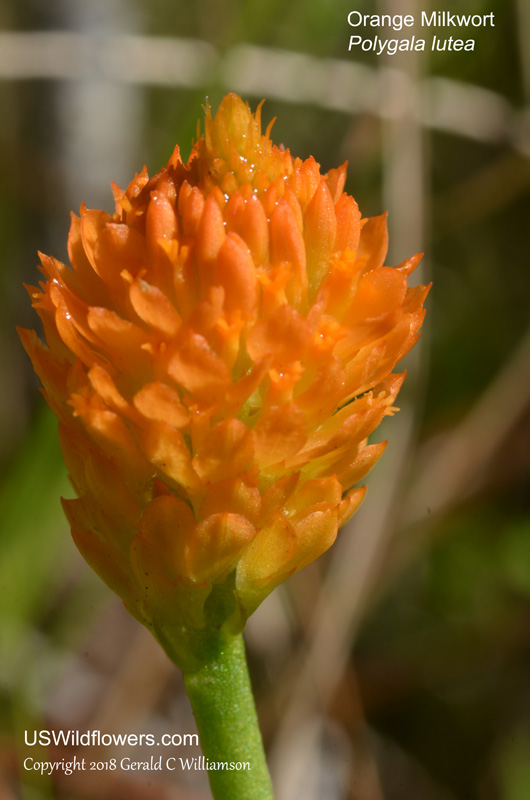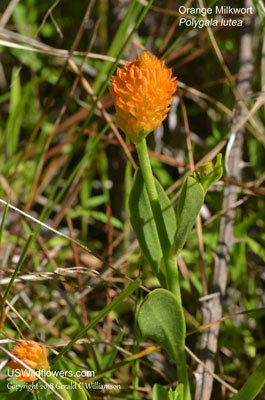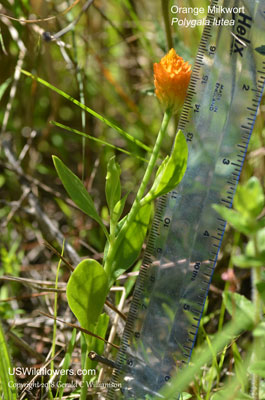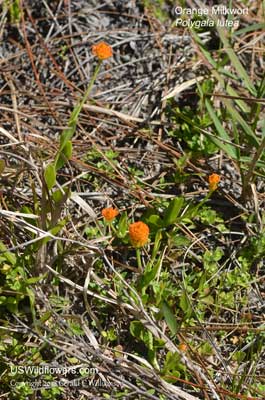Orange Milkwort, Red-hot-poker, Candy Weed, Yellow Milkwort - Polygala lutea
|
Polygala lutea - Orange Milkwort, Red-hot-poker, Candy Weed, Yellow Milkwort.
Polygala - Milkwort - is a very large genus with somewhere between 300 and 500 species worldwide. Recent reclassification probably leaves it closer to the lower end of that number than the high end, but still 300 to 400 species makes for a large genus. 40 - 60 species are found in North America. While more of those are in the eastern half of the continent than in the west, there is at least one species found in all but 2 to 4 states - missing from Alaska and Idaho; its presence in Washington and Nevada is apparently disputed.
Polygala lutea is a plant primarily of the coastal plains of the Mid-Atlantic and Southeastern United States, extend somewhat into the Piedmont regions of these states. It grows in wet sandy or boggy areas of savannahs, pine barrens, and roadsides. The plants here were photographed along a backroad in a pine farm of northeastern Florida, and along a nearby state highway. Synonym: Pylostachya lutea
Found in:
AL, DE, FL, GA, LA, MD, MS, NC, NJ, NY, PA, SC, VA
Leave comments on Polygala lutea at this link. | 
Distribution of Polygala lutea in the United States and Canada:

Map courtesy of The Biota of North America Program.
Map color key
Search Our Database: Enter any portion of the Scientific, Common Name, or both.
Do a general Google search of the entire site:
#ad
 Follow USWildflowers on Twitter
| | Site: Bradford County, FL Date: 2018-April-05 | Photographer: Gerald C. Williamson
Nikon D7000
Tamron SP 90MM f/2.8 AF Macro | | The flowers of Milkwort (Polygala) species have 5 sepals and 3 petals. The inner 2 sepals are petal-like. In some species, the inflorescence is so compact that individual flowers are almost not discernable except under magnification. | | 
| | Site: Bradford County, FL Date: 2018-April-05 | Photographer: Gerald C Williamson
Nikon D7000 | It's clear why "orange" is associated with the common name, while it is not quite so clear why the species epithet is "lutea" - Latin for yellow, and in fact at least one dictionary lists that word as an English adjective for yellow. Occasionally the plant will have yellow flowers, but the epithet is reportedly applied because even the flowers which are orange when fresh will be yellow when dried, so the dried specimens collected for classification were yellow.
There is a rosette of basal leaves - oblong or spatulate to about 2.5" long, and the stem leaves, similarly shaped but smaller, up to about 1.75" long. Upper leaves will be smaller. | | Click on the photo for a larger image

| | Site: Bradford County, FL Date: 2018-April-05 | Photographer: Gerald C Williamson
Nikon D7000 | | Polygala lutea grows up to 18 to 20 inches tall, although this specimen at 16 cm (a bit over 6") was among the tallest of the colony. This is more along the height of the similar Polygala nana, a generally shorter plant with yellow blossoms. Polygala nana has sometimes been classified as Polygala lutea var. nana. | | Click on the photo for a larger image

| | Site: Bradford County, FL Date: 2018-April-05 | Photographer: Gerald C Williamson
Nikon D7000 | | Orange Milkwort can bloom from March to November - not surprising with the range from south Florida up into the Hudson Valley of New York. | | Click on the photo for a larger image

|
References used for identification and information:
|
|
| |
| #ad
|
|






